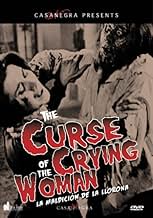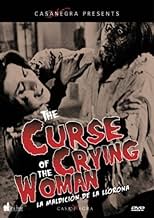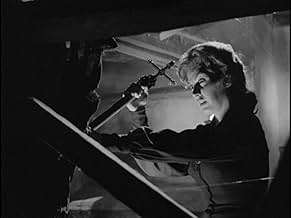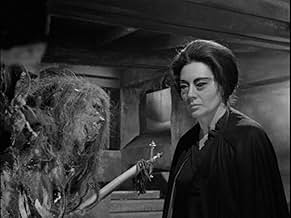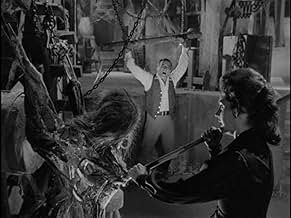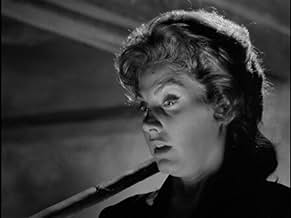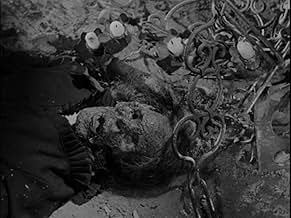AVALIAÇÃO DA IMDb
6,5/10
861
SUA AVALIAÇÃO
Adicionar um enredo no seu idiomaAfter fifteen years of being away, a woman returns with her husband to her aunt's hacienda in the Mexican countryside, without realizing that her relative is a sorceress who wants to use her... Ler tudoAfter fifteen years of being away, a woman returns with her husband to her aunt's hacienda in the Mexican countryside, without realizing that her relative is a sorceress who wants to use her to bring an evil witch back to life.After fifteen years of being away, a woman returns with her husband to her aunt's hacienda in the Mexican countryside, without realizing that her relative is a sorceress who wants to use her to bring an evil witch back to life.
- Direção
- Roteiristas
- Artistas
Carlos López Moctezuma
- Juan
- (as Carlos Lopez Moctezuma)
Avaliações em destaque
I almost feel the urge to spontaneously start a Mexican Wave in honor of this SUBLIME Gothic horror movie! When listing the most important classic horror titles and their countries of origin, people automatically think about Italy (with Mario Bava and his "Black Sunday"), Spain (with about a million Paul Naschy films) and naturally Britain (with the legendary Hammer and Amicus production studios). Mexico understandably always gets left out, but it truly deserves to be mentioned too, if it were only for THIS movie alone! "The Curse of the Crying Woman" is nearly flawless Goth-horror and features all the aspects that make the genre fans' mouths water. Filmed in beautiful black & white and bathing in an uncanny atmosphere, this movie is compelling from start to finish and several eerie images will haunt your thoughts even long afterwards. The story is simplistic, yet effectively creepy, the decors & set pieces are overwhelmingly sinister and the make-up effects are surprisingly convincing. No wonder this film often gets compared to Mario Bava's aforementioned milestone "Black Sunday". If you take the wise decision of purchasing "The Curse of the Crying Woman", you may expect to see endless dark forests, old mansions, ominous thunderstorms and of course a sardonic mythical storyline that tightly connects all these elements together. On the night of her 25th birthday, beautiful Amelia and her husband arrive at her aunts' Selma reputedly "cursed" house. Amelia has been looking forward to be reunited with her aunt since years, but she doesn't know that the sole reason of her invite is to serve as the final sacrifice to resurrect an ancient witch. Throughout the years, Selma became obsessed with the powers of Marina; an evil bitch that lures woods-travelers with her cries and kills them. Even if the young couple manages to avoid the curse, they still need to defeat Selma's horribly scarred servant and the mutated monster in the attic. The tension & atmosphere are masterfully built up, especially during the first 45 minutes. Director Raphael Baledón then seems to lose his tight grip on the story a bit around the hour, but he immediately rectifies himself again with an unforgettable climax. The sequence with the chiming bell alone is worth a standing ovation! Mesmerizing horror experience, recommended to fans of the genre all over the world.
* Special word of thanks to loyal IMDb-user G.B, for helping me to obtain this new personal favorite.
* Special word of thanks to loyal IMDb-user G.B, for helping me to obtain this new personal favorite.
As ever when finally getting a viewing of a film I've been looking forward to, I was worried that The Curse of the Crying Woman may not live up to expectations; but this exquisite slice of Mexican Gothic horror lived up to them all, and then some! Comparisons with the great Mario Bava's masterpiece "Black Sunday" are obviously going to come about, and this story of ancient curses and witchcraft is similar to the earlier sixties film in many ways. The most striking aspect of the film is undoubtedly the atmosphere, and director Rafael Baledón succeeds in creating a foreboding tone throughout the movie, which blends extremely well with the folklore origins of the story. The film is based on the Mexican legend 'La Llorona', and centres on a supposedly cursed mansion in the middle of the woods. We follow Amelia; a young woman who travels to see her Aunt Selma's with her husband. However, it soon becomes apparent that Selma has become obsessed with an ancient witch, whose power she believes can be unlocked by Amelia. People say that the woods are haunted by the crying woman, and Amelia is about to find out a truth to that legend!
It's quite unbelievable that a film of this quality could remain incognito for so long, and full credit must go to Casa Negra for their excellent DVD release. I'm coming to realise that Mexico produced a lot of cheap horror films throughout the sixties and seventies; many of which can't stand tall with the best that the more accomplished nations have to offer, but this is surely one of the very best films to come out of the South American nation. Rafael Baledón's direction is superb, and the outdoor scenes that see the woods and central house surrounded in fog could be framed and hung on the wall, such is their beauty. The film is packed with obscure and fascinating support characters, including the decayed corpse of the witch, which somehow takes on a life of its own, the maniacal servant and deformed family member that is kept in the attic! The conclusion to the film is superb, and the director's use of a huge bell is excellently handled and helps to deliver the scintillatingly Gothic finale that the film deserves. Overall, we horror fans should count ourselves lucky that there are DVD release companies willing to take a chance on unknown films like this one, and every horror fan must see The Curse of the Crying Woman!
It's quite unbelievable that a film of this quality could remain incognito for so long, and full credit must go to Casa Negra for their excellent DVD release. I'm coming to realise that Mexico produced a lot of cheap horror films throughout the sixties and seventies; many of which can't stand tall with the best that the more accomplished nations have to offer, but this is surely one of the very best films to come out of the South American nation. Rafael Baledón's direction is superb, and the outdoor scenes that see the woods and central house surrounded in fog could be framed and hung on the wall, such is their beauty. The film is packed with obscure and fascinating support characters, including the decayed corpse of the witch, which somehow takes on a life of its own, the maniacal servant and deformed family member that is kept in the attic! The conclusion to the film is superb, and the director's use of a huge bell is excellently handled and helps to deliver the scintillatingly Gothic finale that the film deserves. Overall, we horror fans should count ourselves lucky that there are DVD release companies willing to take a chance on unknown films like this one, and every horror fan must see The Curse of the Crying Woman!
While not quite in the same league as THE BLACK PIT OF DR. M (1958) or THE WITCH'S MIRROR (1960), this is yet another fine addition to the great - and largely unheralded - series of classic Mexican horror films. This was actually the fourth of at least five vintage films about the titular creature (in the last of these, she was even pitted against another Mexican legend - Santo the wrestler!): it would be great if the others were revived - no pun intended - as well somewhere along the line by Casanegra or whomever.
Again, the film positively drips with atmosphere and style (belying the miniscule budget on hand) - generally coming off as unmistakably Mexican but also borrowing freely from other horror titles, most notably Mario Bava's seminal BLACK Sunday (1960). As in THE WITCH'S MIRROR - which, incidentally, shared with this film its star Rosita Arenas, producer Abel Salazar (here he essayed the role of the male lead as well) and composer (the ubiquitous Gustavo Cesar Carrion) - weird mirror imagery plays an essential part in the narrative, as does witchcraft, for that matter. The scarred 'monster' of that film as well as THE BLACK PIT OF DR. M, then, is incarnated here not by one but three different figures - The Crying Woman herself, decomposed and awaiting re-animation; her disciple Rita Macedo's hulking and club-footed henchman; and Macedo's once-distinguished husband, whom she has kept locked up for years and who has consequently regressed to a subhuman, animal-like level. Also on hand is a trio of rather skinny-looking Great Danes, which are unleashed from time to time to attack unsuspecting villagers or intruding police officials.
Two of its most compelling sequences are those in which Macedo recounts to Arenas and Salazar (individually) the tale of the "Llorona"; the latter has little real purpose, but its depiction of the events is done through brief snippets of scenes (shown in negative) from other Salazar-produced horror films - I immediately noticed the only shot I'm familiar with up to this point, from THE WITCH'S MIRROR, but shots from THE BRAINIAC (1961; which is next in my Halloween horror marathon!) are included as well, as per the Commentary; besides, here we get an unexpected but effective display of sensuality - which is felt again when Arenas (already in the process of replacing the "Llorona") notices Salazar's bloodied hand. Among the film's indelible images are all the scenes in which the eyes of The Crying Woman's disciples turn completely black - an effect seen in the very first shot and which was later lifted by INVASION OF THE BEE GIRLS (1973); Macedo's bat-like swoop towards the camera and Arenas' hallucination (which is as expressionistic as they come, with the night sky being crammed with staring accusing eyes) are also worth mentioning and striking, too, is the distinctive make-up design for each of the 'monsters'.
The busy climax - in which Salazar and Carlos Lopez Moctezuma (the henchman) engage in a lengthy and energetic fist-fight, and the long-suffering husband Domingo Soler finally gets even with Macedo, as the hacienda collapses around them - is quite splendid. Also notable here is the lighting when the 'possessed' Arenas attempts to liberate the "Llorona" by removing a stake from her body (a scene which, unfortunately, is absurdly over-extended so as to allow the huge bell in the impressive bell-tower set at the top of the mansion - as important to this film as it was to Hitchcock's VERTIGO [1958] - to chime 12 times!). The film features a generous number of effective shock moments and some rather graphic violence for the time: the scene where a girl - played by Macedo's real-life daughter, billed as Julissa del Llano - is trampled by a carriage; one where the pitiful and half-crazed Soler is brutally whipped by the sadistic Moctezuma, until he retaliates (a scene which is heavily reminiscent of Dwight Frye's tormenting of Boris Karloff in James Whale's FRANKENSTEIN [1931]); and especially the dogs' vicious attack on the two constables (sections of which were reportedly trimmed for export versions).
Regrettably, the Audio Commentary for this release turned out to be a major disappointment: not only is there a great deal of dead air on this track, with Michael Liuzza (Casanegra's Vice President, no less!) allowing several of the best scenes to go without comment but, when he does speak, he mainly resorts to biographical details of the various personnel involved!!
Again, the film positively drips with atmosphere and style (belying the miniscule budget on hand) - generally coming off as unmistakably Mexican but also borrowing freely from other horror titles, most notably Mario Bava's seminal BLACK Sunday (1960). As in THE WITCH'S MIRROR - which, incidentally, shared with this film its star Rosita Arenas, producer Abel Salazar (here he essayed the role of the male lead as well) and composer (the ubiquitous Gustavo Cesar Carrion) - weird mirror imagery plays an essential part in the narrative, as does witchcraft, for that matter. The scarred 'monster' of that film as well as THE BLACK PIT OF DR. M, then, is incarnated here not by one but three different figures - The Crying Woman herself, decomposed and awaiting re-animation; her disciple Rita Macedo's hulking and club-footed henchman; and Macedo's once-distinguished husband, whom she has kept locked up for years and who has consequently regressed to a subhuman, animal-like level. Also on hand is a trio of rather skinny-looking Great Danes, which are unleashed from time to time to attack unsuspecting villagers or intruding police officials.
Two of its most compelling sequences are those in which Macedo recounts to Arenas and Salazar (individually) the tale of the "Llorona"; the latter has little real purpose, but its depiction of the events is done through brief snippets of scenes (shown in negative) from other Salazar-produced horror films - I immediately noticed the only shot I'm familiar with up to this point, from THE WITCH'S MIRROR, but shots from THE BRAINIAC (1961; which is next in my Halloween horror marathon!) are included as well, as per the Commentary; besides, here we get an unexpected but effective display of sensuality - which is felt again when Arenas (already in the process of replacing the "Llorona") notices Salazar's bloodied hand. Among the film's indelible images are all the scenes in which the eyes of The Crying Woman's disciples turn completely black - an effect seen in the very first shot and which was later lifted by INVASION OF THE BEE GIRLS (1973); Macedo's bat-like swoop towards the camera and Arenas' hallucination (which is as expressionistic as they come, with the night sky being crammed with staring accusing eyes) are also worth mentioning and striking, too, is the distinctive make-up design for each of the 'monsters'.
The busy climax - in which Salazar and Carlos Lopez Moctezuma (the henchman) engage in a lengthy and energetic fist-fight, and the long-suffering husband Domingo Soler finally gets even with Macedo, as the hacienda collapses around them - is quite splendid. Also notable here is the lighting when the 'possessed' Arenas attempts to liberate the "Llorona" by removing a stake from her body (a scene which, unfortunately, is absurdly over-extended so as to allow the huge bell in the impressive bell-tower set at the top of the mansion - as important to this film as it was to Hitchcock's VERTIGO [1958] - to chime 12 times!). The film features a generous number of effective shock moments and some rather graphic violence for the time: the scene where a girl - played by Macedo's real-life daughter, billed as Julissa del Llano - is trampled by a carriage; one where the pitiful and half-crazed Soler is brutally whipped by the sadistic Moctezuma, until he retaliates (a scene which is heavily reminiscent of Dwight Frye's tormenting of Boris Karloff in James Whale's FRANKENSTEIN [1931]); and especially the dogs' vicious attack on the two constables (sections of which were reportedly trimmed for export versions).
Regrettably, the Audio Commentary for this release turned out to be a major disappointment: not only is there a great deal of dead air on this track, with Michael Liuzza (Casanegra's Vice President, no less!) allowing several of the best scenes to go without comment but, when he does speak, he mainly resorts to biographical details of the various personnel involved!!
10rkolesza
I just watched CasaNegra Entertainment's version of this film on DVD, fully restored and all I can is Wow, they did a great job with it. It's such a treat to see these old Mexican classic finally get the attention they deserve. Curse of the Crying Woman is often considered the the Mexican Black Sunday and it lives up to it in every way. Beautifully filmed entirely at night, creepy mist, candle lit dungeons and dead trees are everywhere. These type visual elements were one of the trademarks in many of great horror films from Meixco and definitely what helps make them unique.
The story involves a young woman who upon visiting her Aunt who lives in a creepy Hacienda mansion in the countryside, learns she is next in line to join a family of evil witches. The Mexican title suggests the film is based on the legend of Llorona which it is only loosely. Baledon takes the real legend and morphs it into his own screen play and the outcome is pure classic horror enjoyment. A must for any true lover of Gothic, Black and White horror movies.
The story involves a young woman who upon visiting her Aunt who lives in a creepy Hacienda mansion in the countryside, learns she is next in line to join a family of evil witches. The Mexican title suggests the film is based on the legend of Llorona which it is only loosely. Baledon takes the real legend and morphs it into his own screen play and the outcome is pure classic horror enjoyment. A must for any true lover of Gothic, Black and White horror movies.
Enter Gothic Mexico! Easily one of the best Horror films of the classic Mexi-Horror era. This film is oozing with the lush atmosphere, bizarre imagery and beautiful, shadowy photography which many of the Mexican horror classics of this era are known for. Like several other classic Mexican horror films, this one also plays off the the old Mexican folklore tale of Llorona, the weeping ghost/witch of the Mexican countryside. Real horror buffs will see (during the opening scene) a striking similarity between this film and Mario Bava's masterpiece, Black Sunday. The setting, where the Witch lives is actually a old Mexican Hacienda Mansion. I think the scenes where this "Haunted" mansion is depicted rivals that of the old Gothic castles which were typically used as settings in the European classics, mainly the Christopher Lee Dracula films. It just looks different but is creepy as can be. There is also some dreamy, almost psychedelic like sequences also not unusual during this period. Combine all this is the mutated, malformed man kept prisoner in the mansion, the boney flesh-eating hounds, Abel Salazar (Brainiac) playing the heroine and Rita Macedo playing the Witch you have a film any horror fan is not likely to forget.
Você sabia?
- CuriosidadesThere have been many film adaptations of the legend, including a 1933 version that is believed to be the first Mexican horror film.
- ConexõesEdited from O Barão do Terror (1962)
Principais escolhas
Faça login para avaliar e ver a lista de recomendações personalizadas
- How long is The Curse of the Crying Woman?Fornecido pela Alexa
Detalhes
- Data de lançamento
- País de origem
- Idioma
- Também conhecido como
- The Curse of the Crying Woman
- Locações de filme
- Empresa de produção
- Consulte mais créditos da empresa na IMDbPro
- Tempo de duração1 hora 20 minutos
- Cor
- Proporção
- 1.37 : 1
Contribua para esta página
Sugerir uma alteração ou adicionar conteúdo ausente

